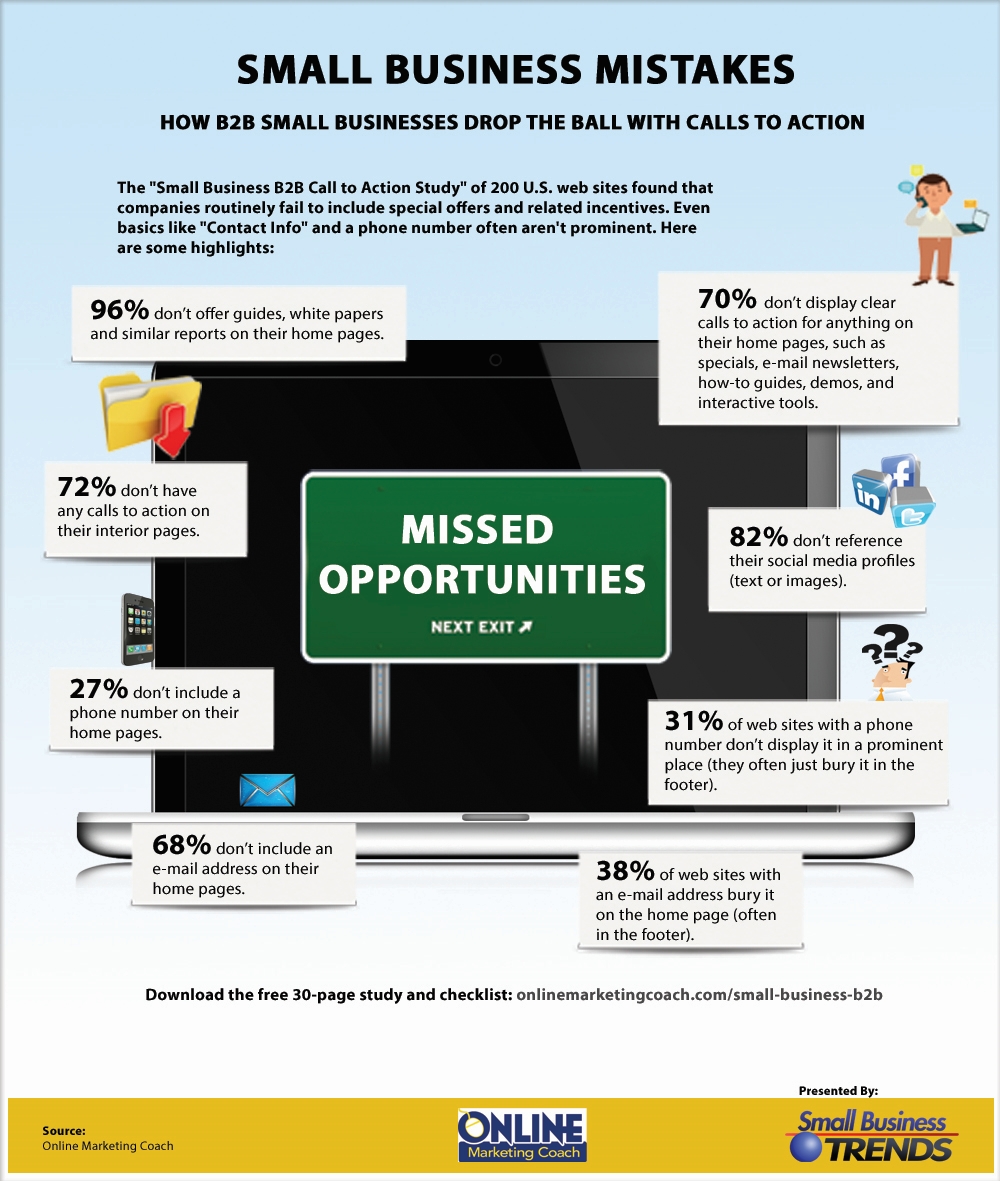A recent study has shown that there is huge potential for small businesses to improve on their lead generation tactics. The “Small Business B2B Call to Action Study” looked at the websites of 200 US based small businesses with fewer than 100 employees, and found that many of these websites fail to include relevant and effective calls-to-action.
In this post we examine some of the main findings of the study, and explain how you can avoid making these mistakes on your website.
96% don’t offer guides, white papers and similar reports on their homepages
B2B companies often use free long form content such as white papers as a way to generate leads. A prospect customer can download the content after submitting their email address via form – this is a great tactic to generate leads. Although these prospects may not be ready to convert just yet, if they find your content useful, it may mean your business is top of mind when they are in a position to make a decision. You can also use the contact details they supply to follow up with them at a later date.
Using the Wufoo widget is a great way to add a form to your website. It will also allow you to set up an automated email which can be triggered to send after a form submission. This email can be used to attach your white paper to after a prospect has submitted their contact information.

Check out the Wufoo form we used for our eBooks in the Get Started Building Your Website series.
70% don’t display clear calls-to-action for anything on their home pages, such as specials, email newsletters, how-to guides, demos, and interactive tools.
When adding calls-to-action to your website, it is important to consider what stage of the buying process your visitor is in. To give an example, you could assume that most people landing on a website homepage are browsing and gathering information, and are therefore not ready to convert just yet. As a result a “buy now” button on the homepage would not be appropriate. This doesn’t mean that your website should not include a CTA, but maybe one that differs from that of an interior page, when a user is further into the decision making process.
As mentioned previously, offering free downloadable long form content on your website is a great tactic to generate leads – as it is a relatively soft sell, it can be featured on the homepage. You could also offer a one-time special on your homepage, for example, a free, no obligation telephone consultation, using your telephone as a clear call-to-action.
Using an email newsletter signup form is another CTA that works well on homepages, and a great way to collect leads. Once you have built up an email list, start email marketing in order to encourage repeat traffic to your website. For example, if you have an online store you can alert customers about promotions or new additions to your inventory, encouraging customers to return to your site and convert. Collecting email addresses and launching your first email marketing campaign is easy with the Constant Contact widget.
82% don’t reference their social media profiles
Social Media is a great way of keeping the conversation going with customers after they have left your website, and can open up new business opportunities. Whether you have a Facebook page, Twitter account , Pinterest board or all of the above, make sure to promote them on your website. Tell prospect customers why they should “Like” you on Facebook, and what they can expect your updates to include.
You can easily add the Share Me widget to your website which allows visitors to Like, Tweet or +1 content on your site. Alternatively upload Social Media images and hyperlink them to your company Social Media profiles. Adding a Pinterest “Follow Me” button is also easy using the HTML widget.

Yola “Share Me” Widget
31% of websites with a phone number don’t display it in a prominent place
Make it easy for prospective customers to get in contact with you by displaying your phone number prominently on your website, preferably on your homepage. A business phone number helps to improve the credibility of your company, and prospect customers will feel more at ease doing business with you if they know they can contact you easily.
If you don’t already have a business phone number, tools like MightyCall can give you a local or toll-free business number which can be forwarded straight to your cell phone.
68% don’t include an email address on their homepages
Similar to a phone number, showing an email address on the homepage of your website can make your customers feel comfortable with your business and are therefore more likely to convert. Personalized email addresses that match your business domain name such as laura.t@yola.com look more professional than a generic @gmail.com email address.
Setting up multiple email addresses for different departments such as. sales@ or support@ could be a good tactic to make your business appear larger, on the flip side of that, email addresses that include a persons name e.g. laura.t@ help to give off a more personal touch which you may desire for your business.
Check out some of the other mistakes made by small businesses in this infographic, and try to avoid making these yourself in 2014.
